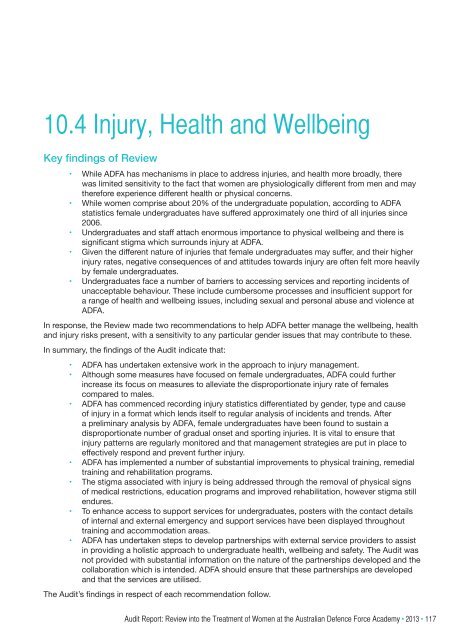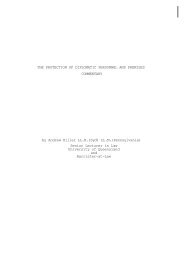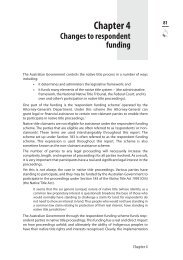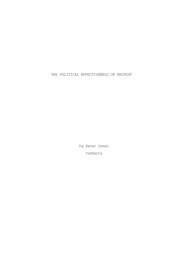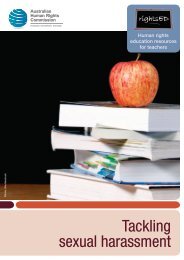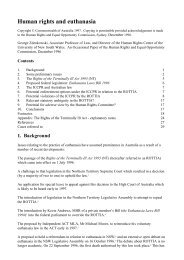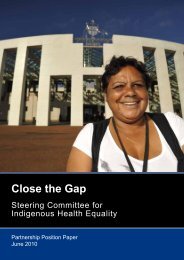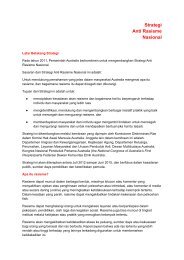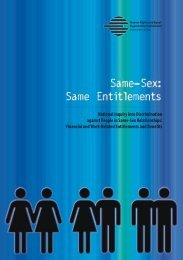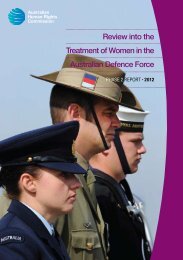Chapter 10: Minimising Risk, Managing Incidents and Ensuring <strong>the</strong> Safety <strong>of</strong> <strong>the</strong> Workplace – Recommend<strong>at</strong>ions 22-3127 CDRE BJ Kafer, ‘Commandant’s Directive 14/12 – ‘Quick assessments and “serious or complex incidents”’’, 24 September2012, provided to <strong>the</strong> Audit by Dr N Miller, 21 November 2012; CDRE BJ Kafer, ‘Commandant’s Directive 15/12 – Oper<strong>at</strong>ion <strong>of</strong><strong>the</strong> Discipline Officer Scheme’, 24 September 2012, provided to <strong>the</strong> Audit by Dr N Miller, 21 November 2012; CDRE BJ Kafer,‘Commandant’s Directive 16/12 – The Reporting and Management <strong>of</strong> Notifiable Incidents’, 24 September 2012, providedto <strong>the</strong> Audit by Dr N Miller, 21 November 2012; CDRE BJ Kafer, ‘Commandant’s Directive 17/12 – ‘Mand<strong>at</strong>ory Disciplineand Administr<strong>at</strong>ive Appointment Training’, 24 September 2012, provided to <strong>the</strong> Audit by Dr N Miller, 21 November 2012;CDRE BJ Kafer, ‘Commandant’s Directive 18/12 – ‘Substances which may be used to produce or cause an <strong>into</strong>xic<strong>at</strong>ing,stupefying or hallucin<strong>at</strong>ory effect’, 24 September 2012, provided to <strong>the</strong> Audit by Dr N Miller, 21 November 2012; CDREBJ Kafer, ‘Commandant’s Directive 19/12 – ‘Reporting and Management Requirements When a <strong>Defence</strong> Member is Absent’,24 September 2012, provided to <strong>the</strong> Audit by Dr N Miller, 21 November 2012; CDRE BJ Kafer, ‘Commandant’s Directive 20/12– ‘Authority to Impose Conditions and/or Restrictions on Leave’, 24 September 2012, provided to <strong>the</strong> Audit by Dr N Miller,21 November 2012; CDRE BJ Kafer, ‘Commandant’s Directive 21/12 – ‘Active management <strong>of</strong> alleg<strong>at</strong>ions/incidents’,24 September 2012, provided to <strong>the</strong> Audit by Dr N Miller, 21 November 2012; Interview 51, SQNLDR A Fullick, 19 February2013.28 Interview 50, senior ADFA staff, 19 February 2013.29 CDRE BJ Kafer, email to <strong>the</strong> Audit, 22 February 2013.30 Interview 50, senior ADFA staff, 19 February 2013.31 Notifiable incidents are incidents th<strong>at</strong> are reported to ADFIS, have been reported to ADFA by police or internal mechanismssuch as <strong>the</strong> ADF Whistleblower scheme, or those which would warrant a Hot Issues Brief and/or a Ministerial Submission.32 Interview 47, senior ADFA staff, 19 February 2013; CDRE BJ Kafer, email to <strong>the</strong> Audit, 22 February 2013.33 Focus group U14, Mixed Service 1st year undergradu<strong>at</strong>e male and female, 16 October 2012.34 Interview 47, senior ADFA staff, 19 February 2013. Such investig<strong>at</strong>ions are separ<strong>at</strong>e from ADFA’s internal processes, and involvefinding an available investig<strong>at</strong>or, organising <strong>the</strong> instruments <strong>of</strong> appointment, conducting <strong>the</strong> investig<strong>at</strong>ion and legal review.35 Interview 47, senior ADFA staff, 19 February 2013.36 Interview 47, senior ADFA staff, 19 February 2013.116
10.4 Injury, Health and WellbeingKey findings <strong>of</strong> <strong>Review</strong>• While ADFA has mechanisms in place to address injuries, and health more broadly, <strong>the</strong>rewas limited sensitivity to <strong>the</strong> fact th<strong>at</strong> <strong>women</strong> are physiologically different from men and may<strong>the</strong>refore experience different health or physical concerns.• While <strong>women</strong> comprise about 20% <strong>of</strong> <strong>the</strong> undergradu<strong>at</strong>e popul<strong>at</strong>ion, according to ADFAst<strong>at</strong>istics female undergradu<strong>at</strong>es have suffered approxim<strong>at</strong>ely one third <strong>of</strong> all injuries since2006.• Undergradu<strong>at</strong>es and staff <strong>at</strong>tach enormous importance to physical wellbeing and <strong>the</strong>re issignificant stigma which surrounds injury <strong>at</strong> ADFA.• Given <strong>the</strong> different n<strong>at</strong>ure <strong>of</strong> injuries th<strong>at</strong> female undergradu<strong>at</strong>es may suffer, and <strong>the</strong>ir higherinjury r<strong>at</strong>es, neg<strong>at</strong>ive consequences <strong>of</strong> and <strong>at</strong>titudes towards injury are <strong>of</strong>ten felt more heavilyby female undergradu<strong>at</strong>es.• Undergradu<strong>at</strong>es face a number <strong>of</strong> barriers to accessing services and reporting incidents <strong>of</strong>unacceptable behaviour. These include cumbersome processes and insufficient support fora range <strong>of</strong> health and wellbeing issues, including sexual and personal abuse and violence <strong>at</strong>ADFA.In response, <strong>the</strong> <strong>Review</strong> made two recommend<strong>at</strong>ions to help ADFA better manage <strong>the</strong> wellbeing, healthand injury risks present, with a sensitivity to any particular gender issues th<strong>at</strong> may contribute to <strong>the</strong>se.In summary, <strong>the</strong> findings <strong>of</strong> <strong>the</strong> Audit indic<strong>at</strong>e th<strong>at</strong>:• ADFA has undertaken extensive work in <strong>the</strong> approach to injury management.• Although some measures have focused on female undergradu<strong>at</strong>es, ADFA could fur<strong>the</strong>rincrease its focus on measures to allevi<strong>at</strong>e <strong>the</strong> disproportion<strong>at</strong>e injury r<strong>at</strong>e <strong>of</strong> femalescompared to males.• ADFA has commenced recording injury st<strong>at</strong>istics differenti<strong>at</strong>ed by gender, type and cause<strong>of</strong> injury in a form<strong>at</strong> which lends itself to regular analysis <strong>of</strong> incidents and trends. Aftera preliminary analysis by ADFA, female undergradu<strong>at</strong>es have been found to sustain adisproportion<strong>at</strong>e number <strong>of</strong> gradual onset and sporting injuries. It is vital to ensure th<strong>at</strong>injury p<strong>at</strong>terns are regularly monitored and th<strong>at</strong> management str<strong>at</strong>egies are put in place toeffectively respond and prevent fur<strong>the</strong>r injury.• ADFA has implemented a number <strong>of</strong> substantial improvements to physical training, remedialtraining and rehabilit<strong>at</strong>ion programs.• The stigma associ<strong>at</strong>ed with injury is being addressed through <strong>the</strong> removal <strong>of</strong> physical signs<strong>of</strong> medical restrictions, educ<strong>at</strong>ion programs and improved rehabilit<strong>at</strong>ion, however stigma stillendures.• To enhance access to support services for undergradu<strong>at</strong>es, posters with <strong>the</strong> contact details<strong>of</strong> internal and external emergency and support services have been displayed throughouttraining and accommod<strong>at</strong>ion areas.• ADFA has undertaken steps to develop partnerships with external service providers to assistin providing a holistic approach to undergradu<strong>at</strong>e health, wellbeing and safety. The Audit wasnot provided with substantial inform<strong>at</strong>ion on <strong>the</strong> n<strong>at</strong>ure <strong>of</strong> <strong>the</strong> partnerships developed and <strong>the</strong>collabor<strong>at</strong>ion which is intended. ADFA should ensure th<strong>at</strong> <strong>the</strong>se partnerships are developedand th<strong>at</strong> <strong>the</strong> services are utilised.The Audit’s findings in respect <strong>of</strong> each recommend<strong>at</strong>ion follow.Audit Report: <strong>Review</strong> <strong>into</strong> <strong>the</strong> Tre<strong>at</strong>ment <strong>of</strong> Women <strong>at</strong> <strong>the</strong> <strong>Australian</strong> <strong>Defence</strong> <strong>Force</strong> Academy • 2013 • 117
- Page 1 and 2:
Review into the Treatmentof Women a
- Page 3:
Audit Report:Review into the Treatm
- Page 6 and 7:
ContentsA Message from the Commissi
- Page 8 and 9:
A Message from the CommissionerADFA
- Page 10 and 11:
Chapter 1:Audit ApproachThe Report
- Page 12 and 13:
Chapter 1: Audit ApproachThe Audit
- Page 14 and 15:
Chapter 2: Summary of Audit Finding
- Page 16 and 17:
Chapter 2: Summary of Audit Finding
- Page 18 and 19:
Chapter 2: Summary of Audit Finding
- Page 20 and 21:
Chapter 3: MethodologyQuantitative
- Page 22 and 23:
Chapter 4:Implementationof ReviewRe
- Page 25 and 26:
Organisational PressuresDefence is
- Page 27 and 28:
[My awareness is] pretty limited I
- Page 30 and 31:
Chapter 5:ADFA’s Role andPurposeR
- Page 32 and 33:
Chapter 5: ADFA’s Role and Purpos
- Page 34 and 35:
Chapter 5: ADFA’s Role and Purpos
- Page 36:
Chapter 5: ADFA’s Role and Purpos
- Page 40 and 41:
Chapter 6:Equity and DiversityRecom
- Page 42 and 43:
Chapter 6: Equity and Diversity - R
- Page 44 and 45:
Chapter 6: Equity and Diversity - R
- Page 46 and 47:
Chapter 6: Equity and Diversity - R
- Page 48 and 49:
Chapter 6: Equity and Diversity - R
- Page 50 and 51:
Chapter 6: Equity and Diversity - R
- Page 52 and 53:
Chapter 7:ADFA’s Structure andSta
- Page 54 and 55:
Chapter 7: ADFA’s Structure and S
- Page 56 and 57:
Chapter 7: ADFA’s Structure and S
- Page 58 and 59:
Chapter 7: ADFA’s Structure and S
- Page 60 and 61:
Chapter 7: ADFA’s Structure and S
- Page 62 and 63:
Chapter 7: ADFA’s Structure and S
- Page 64 and 65:
Chapter 7: ADFA’s Structure and S
- Page 66 and 67:
Chapter 7: ADFA’s Structure and S
- Page 68 and 69:
Chapter 7: ADFA’s Structure and S
- Page 70 and 71:
Chapter 7: ADFA’s Structure and S
- Page 72 and 73: Chapter 8:Midshipmen and Cadetsare
- Page 74 and 75: Chapter 8: Midshipmen and Cadets ar
- Page 76 and 77: Chapter 8: Midshipmen and Cadets ar
- Page 78 and 79: Chapter 8: Midshipmen and Cadets ar
- Page 80 and 81: Chapter 8: Midshipmen and Cadets ar
- Page 82 and 83: Chapter 8: Midshipmen and Cadets ar
- Page 84 and 85: Chapter 8: Midshipmen and Cadets ar
- Page 86 and 87: Chapter 9:Accommodation andSupervis
- Page 88 and 89: Chapter 9: Accommodation and Superv
- Page 90 and 91: Chapter 9: Accommodation and Superv
- Page 92 and 93: Chapter 9: Accommodation and Superv
- Page 94 and 95: Chapter 9: Accommodation and Superv
- Page 96 and 97: Chapter 9: Accommodation and Superv
- Page 98 and 99: Chapter 10: Minimising Risk, Managi
- Page 100 and 101: Chapter 10: Minimising Risk, Managi
- Page 102 and 103: Chapter 10: Minimising Risk, Managi
- Page 104 and 105: Chapter 10: Minimising Risk, Managi
- Page 106 and 107: Chapter 10: Minimising Risk, Managi
- Page 108 and 109: Chapter 10: Minimising Risk, Managi
- Page 110 and 111: Chapter 10: Minimising Risk, Managi
- Page 112 and 113: Chapter 10: Minimising Risk, Managi
- Page 114 and 115: Chapter 10: Minimising Risk, Managi
- Page 116 and 117: Chapter 10: Minimising Risk, Managi
- Page 118 and 119: Chapter 10: Minimising Risk, Managi
- Page 120 and 121: Chapter 10: Minimising Risk, Managi
- Page 124 and 125: Chapter 10: Minimising Risk, Managi
- Page 126 and 127: Chapter 10: Minimising Risk, Managi
- Page 128 and 129: Chapter 10: Minimising Risk, Managi
- Page 130 and 131: Chapter 10: Minimising Risk, Managi
- Page 132 and 133: Chapter 10: Minimising Risk, Managi
- Page 135 and 136: Further InformationAustralian Human


